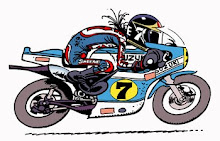
HO means Houzé - Offenstadt, and if the second name is very well known in the motorcycle world, the first probably does not
ring a bell. In fact, although not belonging to the world of racing, Bernard and Michel Houzé were very quickly seduced by
Eric's ideas and they decided to finance the operation by devoting a large budget to the creation and development of the HO.
They deserved, therefore, to be associated with the motorcycle's surname.
The 497cc engine is conventionally powered by two 32 millimeter Gurtner carburettors and two 28 millimeter carburetors in an
additional intake. The cylinders were designed by Eric Offenstadt and produced by a company specializing in high precision
work, FIMA, a company which had already made the cylinder heads of the 12-cylinder Matra and therefore had serious
references. The gearbox uses Yamaha components, but a number of special gears had to be made, while the water pump also comes
from a TZ, and the clutch uses discs from the same machine. A Femsa ignition equips the HO, while the crankshaft comes from
Kawasaki. Single-segment Mahle pistons sit in the cylinders. The most revolutionary
aspect of this engine is that it uses four Gurtner carburetors. Each cylinder has a double intake, seven
transfers and an exhaust, for a total of ten "holes". The classic rear intake is carried out through the piston skirt while
the additional front intake is equipped with an anti-backflow system.
The SMAC alloy monocoque frame has the particularity of being split into two parts along the median axis of the motorcycle. Note that the machine can carry 25 liters of fuel,
including the 9 liters in the hull.
The wheels are six-spoke SMAC magnesium with Michelin tires. The brakes are Brembo calipers and discs with a diameter of 255
millimeters in the front and 200 millimeters for the small rear disc. Two special Carbon oleopneumatic shock absorbers
special made for this bike sit at the back. They perform in the most efficient way, without it being
necessary to intervene in the adjustment.
At the front the bike has an ultra distinctive superradical trailing-link suspension with a Carbon shock absorber adjustable in pre-compression and hardness. A second updated version of this bike is known as the But 500.
Characteristics
Engine
Type 500 HO 2 cylinder
Watercooled 2-stroke
Bore and stroke: 71 x 62.8
Compression ratio: 8.5 to 1
Power: 80 hp at 10,500 rpm
Power supply: dual intake: 2 carbs per cylinder
Rear: diameter 32 Gurtner
Front: diameter 28 Gurtner
Ignition: Femsa
Chassis
Frame: aluminum monocoque
Front suspension: 1 of Carbon adjustable. Travel: 15 cm
Rear suspension: 2 Carbon oleopneumatic. Travel: 13 cm
Front brake: 255 mm diameter discs
Rear brake: 200 mm diameter disc
Front wheel: 3.50 x 18
Rear wheel: 3.50/5.10 x 18
Performance: 272 km/h at 9700 rpm
Weight: 115 kg
For more pics see
Want to know how it sounds see












